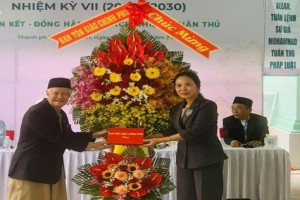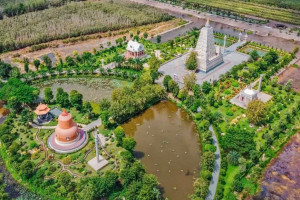
Christian and Missionary Alliance (CMA) brought Protestantism to Vietnam in the late nineteenth and early twentieth centuries. Thus, the arrival of Protestantism was considerably later than other exogenous religions.
In 1887, Pastor A.B. Simpson (Ph.D) – the founder of CMA – visited Vietnam to assess the situation while he was doing missionary work in Huanan, China.
In 1911, Pastor R.A. Jaffray together with two other pastors (P.M. Hosler and G.L. Hughes) arrived in Đà Nẵng (Tourane) and built the first Protestant missionary base with the assistance of Mr. Bornet from the Bible Society. (He had arrived in Đà Nẵng in 1902.) Thus, the year 1911 is considered as the landmark for the beginning of Protestantism in Vietnam.
In 1914, there were nine Protestant CMA clergy in Vietnam. By 1921, the number of clergy had doubled, and then tripled by 1927. From Đà Nẵng, the CMA clergy expanded missionary work to contiguous areas and sent missionaries to disseminate Protestantism to the country’s Northern and Central regions. After seven years, CMA had established five chapters in the North, six chapters in the Center, and five chapters in the South. The French Resident Superior and the Vietnamese Royal Court permitted all those chapters to operate under the name of Mission Évangélique de l’Indochine Française (MEI, Evangelical Mission of French Indochina).
Between 1914 and 1925, CMA clergy, with the assistance of several Vietnamese Confucian scholars, translated the Bible into the Vietnamese Latin script to help disseminate Protestantism. In 1921, a Protestant church was built in Hà Nội, and a Bible School opened in Đà Nẵng. During three consecutive years – 1924, 1925, and 1926 – CMA organized retreats and congregational prayer meetings in Đà Nẵng and plenary congresses to decide on religious affairs. In 1927, the 4th Plenary Congress officially elected a Central Management Board of the Vietnamese General Confederation of Evangelical Churches under the name Mission Évangélique de l’Indochine Française.
Then, in 1945, the name was changed to the one still used today: Vietnamese General Confederation of Evangelical Churches. The 5th Plenary Congress (1928) adopted its “Regulations of the Church", which were revised during the 8th Congress (1936) and implemented as the “1936 Regulations". The 5th Plenary Congress had decided to divide Protestantism in Vietnam into two regions: Northern-Central and Southern. In 1931 it was divided into three regions: Northern, Central and Southern. This division existed until 1954.
In 1926, 15 years after the first CMA foundation was established in Đà Nẵng (1911), A.H. Jackson, a Canadian pastor from the Seventh-Day Adventist Church, arrived in the Central Highlands to look for new missionary opportunities. In 1929, the Seventh-Day Adventists began missionary work in Southern Vietnam.
Until 1945, Vietnam had about 15,000 Protestants with 100 chapters. In 1954, there were more than 60,000 Protestants with 154 chapters and nearly 100 pastors and missionaries. Among them were 6,000 ethnic minority people in the Central Highlands.
After the Geneva Agreement (1954), Protestantism developed differently in the North and the South. The majority of followers and clergy in the North fled to the South. The headquarters of the Vietnamese General Confederation of Evangelical Churches moved to Sài Gòn. There remained in the North only about 1,000 followers and a dozen pastors and preachers. After three years maintaining chapters, in 1955, the followers and pastors in the North established their own church and named it the Vietnamese Confederation of Evangelical Churches (Northern Region), called “Northern Evangelical Church” for short. The church had two organizational levels – the central confederation level and the grassroots chapter level. The 1958 Church Congress decided to draft its own “Regulations". After some time drafting, in 1962, the 8th Congress held in Hà Nội adopted its official “Regulations of the Northern Evangelical Church", which were approved by the Government of the Democratic Republic of Vietnam in 1963. They were subsequently called as the “1963 Regulations". These regulations adopted the Church’s motto as “Worship of God and love of nation". Between 1962 and 2009, the Vietnamese Confederation of Evangelical Churches (Northern Region) held 26 congresses. The 33nd Congress of the Northern Church met from 24 - 26 February 2009 and elected its Central Management Board for the 2009-2013 term.
Between 1954 and 1975, CMA took advantage of the political situation in the South and worked even harder to advance its missionary work by investing money, providing facilities, and sending clergy to help the Vietnamese General Confederation of Evangelical Churches (Southern Region), called as the “Southern Evangelical Church” for short, build up an organizational system and expand its religious, economic, and social establishments. CMA and the Southern Evangelical Church paid particular attention to promoting Protestantism in the ethnic minority areas of the Central Highlands.
In addition to the Southern Evangelical Church, during this time there were also a number of other Protestant denominations which had either detached from the Southern Evangelical Church or had been imported from outside, mainly from Northern America. These included: The Mennonites in 1954, the United World Mission in 1956, the Baptists in 1959, World Vision in 1959, the Disciples of Christ in 1963, Jehovah’s Witnesses in 1965, the Assemblies of God of the Pentecostal in 1970, and some others.
After the liberation of the South, the religious establishments of the Southern Evangelical Church, the Seventh-Day Adventists, United World Mission, Baptists, and some other denominations kept operating as usual. However, the Government did not yet accept the legal status of the Southern Evangelical Church for several reasons, including the fact that some Protestants, especially those in the Central Highlands, were allied with reactionaries from FULRO (Front Unifie de Lutte des Races Opprimees – United Front for the Liberation of Oppressed Races).
In October 2000, the Southern Evangelical Church established a Plenary Congress Action Committee with 24 pastors. In January 2001, the 43rd Congress of the Vietnamese General Confederation of Evangelical Churches (Southern Region) convened in Hồ Chí Minh City with 382 delegates, including pastors, evangelists, and representative followers from all chapters. Among these were 58 pastors, missionaries, and lay people from provinces in the Central Highlands. The Congress adopted a new charter (called the “2001 Charter”), determined the official name of the Vietnamese General Confederation of Evangelical Churches (Southern Evangelical Region), and elected a Central Management Board with 23 pastors and missionaries.
This Congress accepted a motto for the religious activities of the Southern Evangelical Church as follows: “Living the Gospel, worshipping God, and serving the Homeland and the nation". It further noted:
“The Vietnamese General Confederation of Evangelical Churches (Southern Region) operates in accordance with the Constitution and laws of the Socialist Republic of Vietnam and abides by the regulations of State authorities.
It regularly educates its followers about patriotism, civic obligations, the observance of laws, and the spirit of solidarity among the population in order to contribute to national construction of the Homeland, national defense, and peacekeeping".
The “2001 Charter” stipulates the organization of the General Confederation on two levels: The general confederation level and the chapter level (grassroots chapters). The Church’s organization includes representative committees or representatives at the provincial and city level. The term of the Central Management Board of the General Confederation is four years, while the terms of the Representative Committees, Representatives, and Grassroots Management Boards are two years. In forming a new organizational structure, the “2001 Charter” aimed at framing a religious organization with its own base independent of, though relating to the foreign Protestant organizations.
The second (44th according to the church calendar) Congress of the Vietnamese General Confederation of Evangelical Churches (Southern Region) convened from 1-4 March 2005 in Hồ Chí Minh City, where a Central Management Board was elected with 23 members.
The third (45th according to the church calendar) Congress of the Vietnamese General Confederation of Evangelical Churches (Southern Region) convened from 3-6 March 2009 also in Hồ Chí Minh City, and a new Central Management Board was elected for the term from 2009 to 2013.




